National Radio Dynamic Zone (NRDZ)
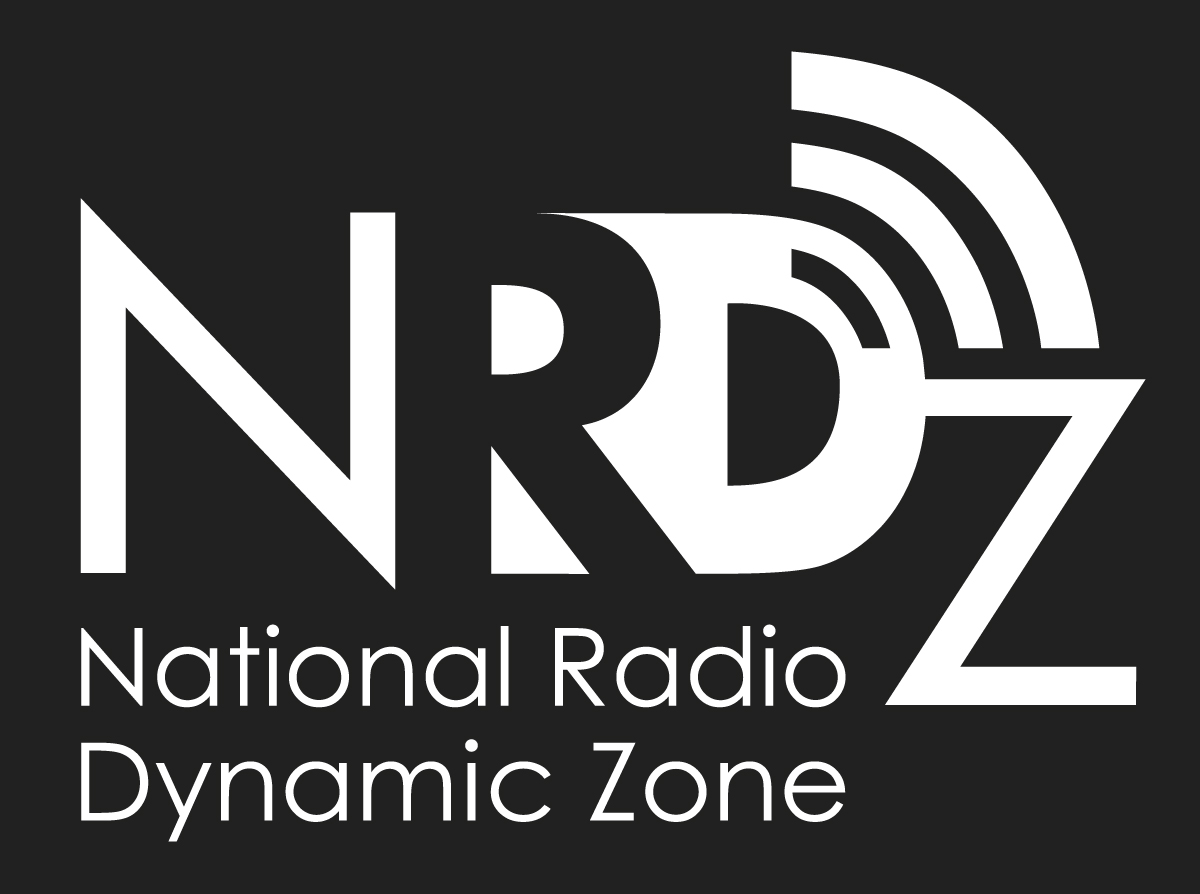
The original NSF-funded National Radio Dynamic Zone (NRDZ) project (2021) supported (1) the development of an NRDZ concept definition, (2) design and development of prototype advanced spectrum monitor (ASM) devices, and (3) broader impact efforts related to spectrum awareness and spectrum management. This article (2018) appears to be the origin of the idea of an NRDZ.
Since 2021, NRAO has continued to expand its efforts in NRDZ, including a Spectrum Innovation Initiative (SII-NRDZ) grant (2022) and a SWIFT-SAT grant (2023). The SWIFT-SAT grant in particular focuses on the development of Operational Data Sharing, or ODS. Below are introductions to some details of each of these funded efforts.
Operational Data Sharing (ODS):
Low Earth orbit (LEO, orbit altitude around 2,000 km) satellite constellations bring broadband internet and cell phone service to the most remote locations on the planet. Unfortunately, many of those remote locations also host some of the world’s great optical and radio observatories. With the number of LEO satellites expected to increase by an order of magnitude in the upcoming decade, radio frequency interference (RFI) from these satellites is a growing concern in protected radio-quiet areas like the United States National Radio Quiet Zone (NRQZ). When these satellites transmit in the spectrum near a radio astronomy (RA) band, undesired out-of-band emission (OOBE) can leak into the RA band and impact the observations in protected bands.
Although passive RFI mitigation techniques, such as kurtosis-based flagging, real-time tracking, and machine learning classification, have had some success in removing RFI from scientific data, RFI-free radio spectrum for astronomical research has been an increasingly precious and diminishing resource. It is imperative to adopt an agile spectrum access framework allowing multiple users to be mutually aware and share their respective licensed and unlicensed bands efficiently.
The National Radio Astronomy Observatory (NRAO), under the NSF's SWIFT-SAT grant AST-2332422, has developed the Operational Data Sharing (ODS) system which publishes radio telescopes’ observation information to a protected database for satellite operators to query through a representational state transfer (REST) API. Satellite operators can use these data to adjust their downlink tasking algorithms in real time to avoid sensitive RA facilities. The ODS JSON data and API standards are shared with the radio astronomy community and satellite vendors. For more details, please visit the public documentation website and the API developer notes , along with our public news release"
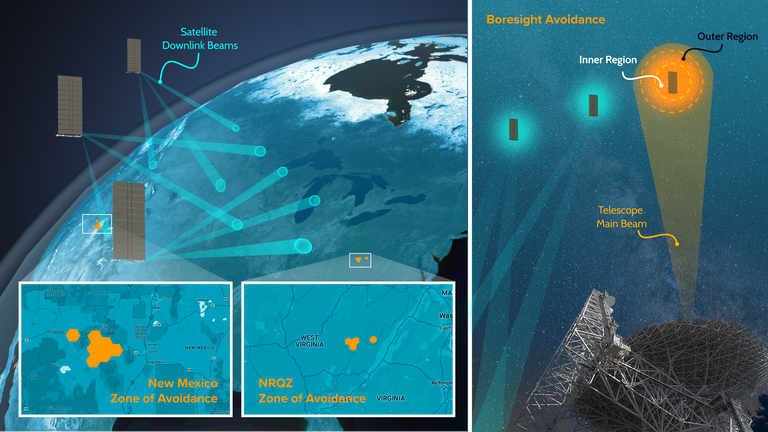
Operational Data Sharing (ODS) is a way for NRAO telescopes to report their current sky pointing and frequency to satellite operators, who can then reduce their emissions towards the telescope.
NRDZ Concept Definition:
When we consider precisely what an NRDZ might be, we need to carefully explore how it would potentially be used by various stakeholder communities. While communities and subcommunities have differing use cases, the unifying motivator for all stakeholders that has come through clearly in discussions is increased spectrum access. That is, passive users (radio astronomy and remote sensing) are developing receivers with ever wider bandwidths to increase sensitivity (and reduce observing time), and active users are developing transmitters and receivers that require broader bandwidth for faster throughput of information for an increasing number of wireless-enabled systems.
There are two fundamentally different NRDZ models that have been discussed, referred to in some stakeholder discussions as (1) a “Coordination Zone” (with various levels of management and enforcement), versus (2) a “Wild West” (with little to no enforcement). Both have advantages and disadvantages, but to be clear, some sort of coordination, management and monitoring will be required in either model. In general, the first model is more appealing to the radio astronomy and remote sensing communities, as careful coordination (manual or automated) will be required for sensitive receivers to function in the coming decades. The second model is more appealing to the active community because it would allow a large amount of freedom in the testing of new equipment, and the testing of new theoretical models of propagation.
For all stakeholders, an NRDZ could provide an established location to perform both individual and coordinated experiments that allow them to utilize broader bandwidth. Controlled experiments performed in an NRDZ may have wider applicability if proven there. There have been a number of workshops that explore the idea of an NRDZ. The NRDZ partnership website contains a summary of discussions that took place during 2021-2023. NRAO has been a partner in organizing and leading these discussions, and the Green Bank Observatory will host an NRDZ conference in September 2024.
In order for an NRDZ to succeed, all potential users must be able to point to tangible benefits to their community. In stakeholder discussions thus far, this appears to be possible. In an NRDZ, active users would gain managed access to spectrum currently not available. Passive users would gain access to broad bandwidth observing without the need to undertake complex RFI monitoring and mitigation, and potentially the opportunity to test automated coordination systems with next generation wireless transmitters.
Broader Impacts:
The NRDZ Broader Impacts curriculum includes a citizen science project, a high school curriculum, and an undergraduate curriculum, all focused on increasing the number of students and citizens aware of the spectrum as a finite resource for both science and commerce. These curricula are now complete, and have been made available via the Superknova website. New funding from the NSF is enabling NRAO to work on several new projects in 2024, including the development of an RFI demonstration for science museums and an RFI Citizen Science project.
Advanced Spectrum Monitor (ASM):
One of the NRDZ deliverables is to design, develop and oversee the installation of an ASM prototype. The initial "proof of concept" device was tested in May 2023 at both the Central Development Laboratory (CDL) in Charlottesville and the Green Bank Observatory (GBO). Lessons learned from the testing of this device have been folded into the successor device, dubbed ASM-2.
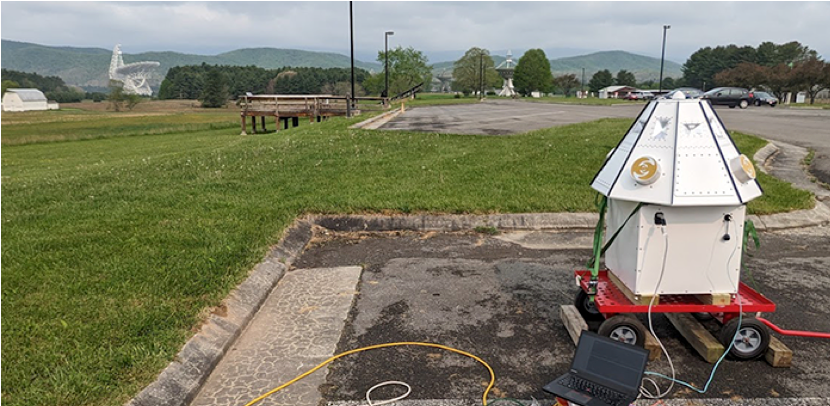
The "Proof of concept" ASM-1 device deployed for testing at the GBO in May 2023.
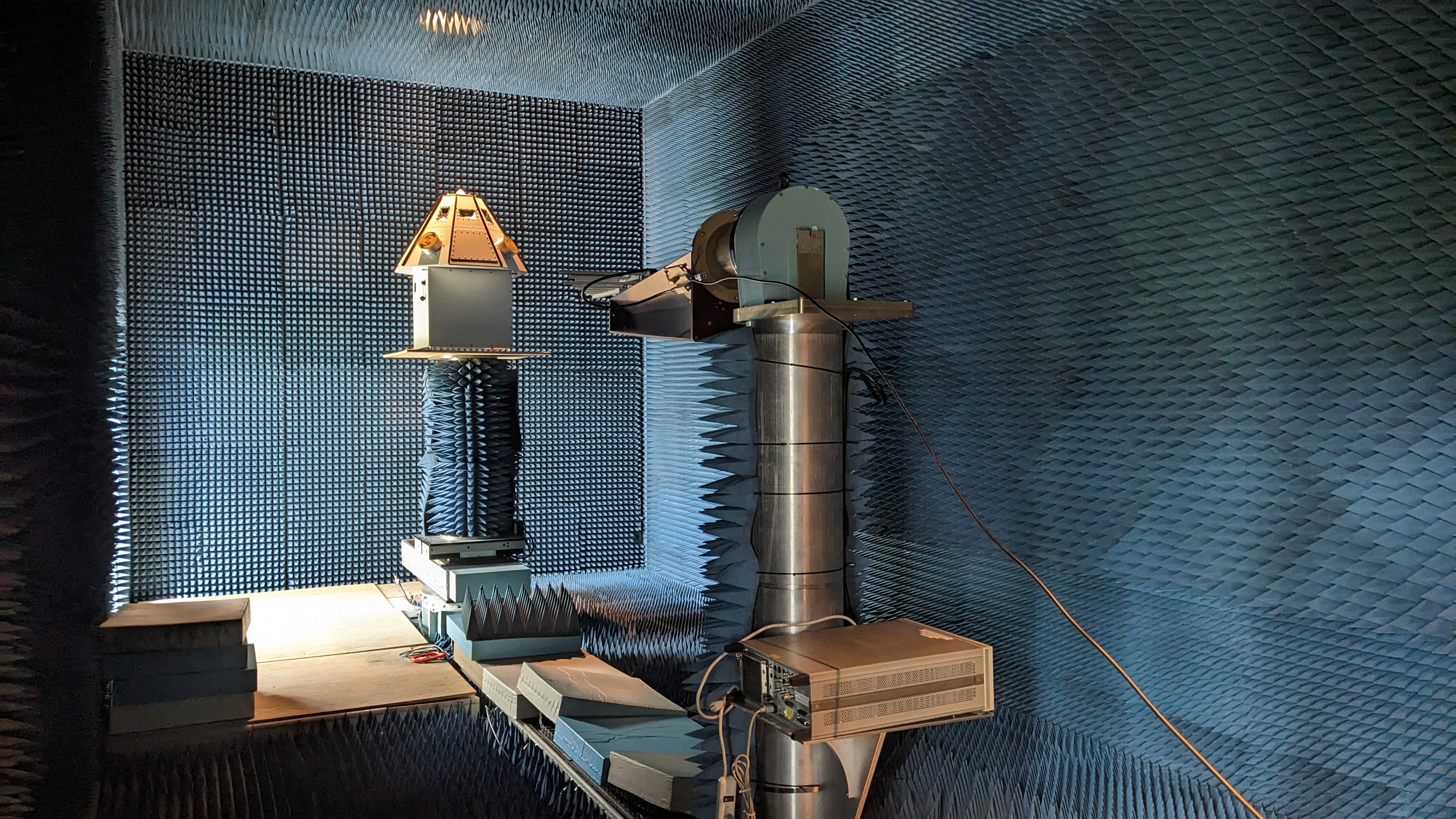
ASM-1 (Proof of Concept Device) during on site RFI (anechoic chamber, above) and field testing at the Green Bank Observatory (below) in May 2023.

The first "proof of concept" device was capable of receiving, determining vectors to, and categorizing signals from frequencies of 1 to 20 GHz. Hemispherical coverage is required as potential interferers can be terrestrial or space borne. Frequency, Signal strength, Polarization and Spectral Occupancy was measured and logged by the device.
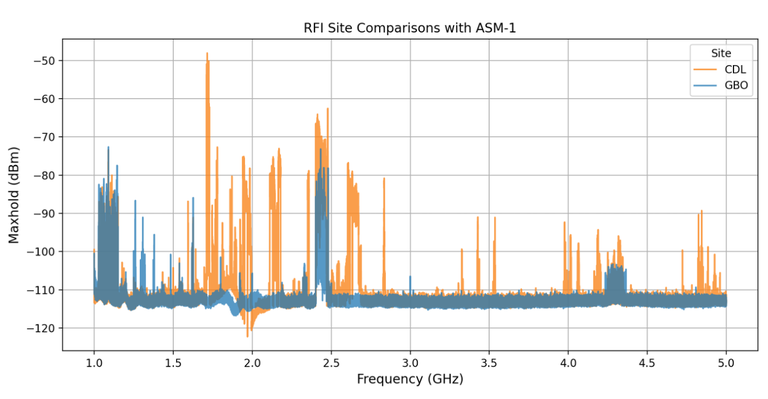
Sample spectra from 1-5 GHz taken with the ASM-1 device at CDL (orange) and GBO (blue). While the RFI environment is clearly better at the GBO, the National Radio Quiet Zone (NRQZ) is not completely quiet. Signals near 2.4 GHz are from WIFI networks.
The ASM-1 and ASM-2 are both designed in the form of a pyramid with multiple antennas built into the perimeter of the outer shell. This configuration has allowed for the device to determine azimuth and elevation of emitters. Each antenna is sampled individually, allowing for the amplitude measurements to be entered into an algorithm that will determine a two-dimensional vector (azimuth, elevation) to the radiating source.
The ASM-2, currently being tested and assembled at the CDL will expand frequency coverage from 1-50 GHz, covering the same range of frequencies observed by the JVLA in New Mexico.

Current (January 2024) mechanical drawing of the ASM-2 enclosure. Access to the faces is enabled by hinged doors. Device will be able to be secured and operated in an outdoor environment.
Update (August 2024): ASM-2 development continues with the construction of the first redesigned sinuous antenna (below) that will be sensitive to the lower portion of the of the spectrum (1-20 GHz). The full device will cover 1-50 GHz. One of these antennas will be on each face of the new ASM-2, giving direction finding capability to the spectrum monitoring device.

The first redesigned ASM-2 Sinuous Antenna on the bench at the Central Development Lab (CDL) in Charlottesville, VA.
NRDZ LOGOS
These logos are freely available for use by any NRDZ-related projects. If there are different formats needed, please reach out to the NRDZ Project Director, Chris De Pree.
| Color EPS Logo | Color JPG Logo |
| B&W EPS Logo | B&W JPG Logo |

